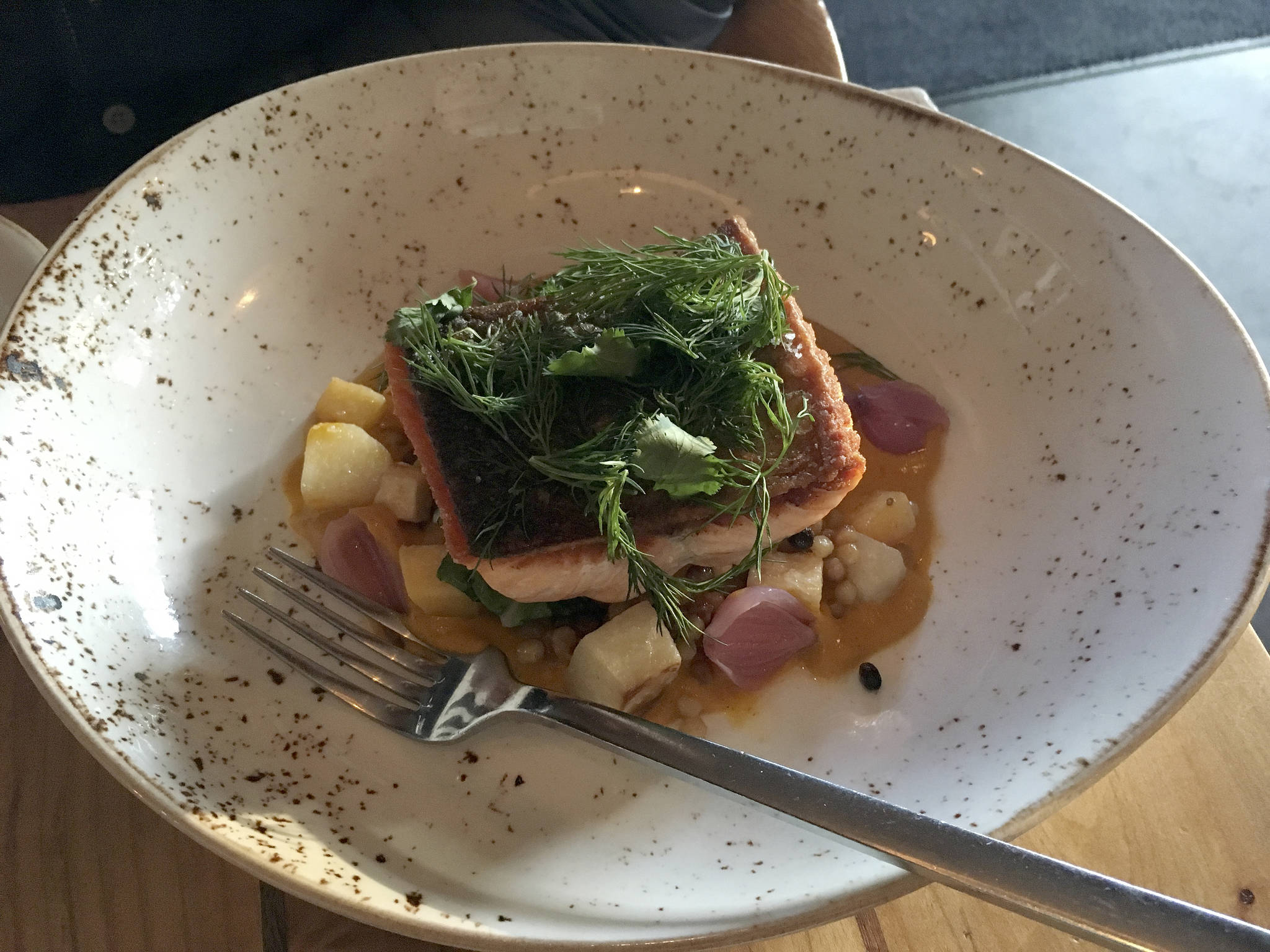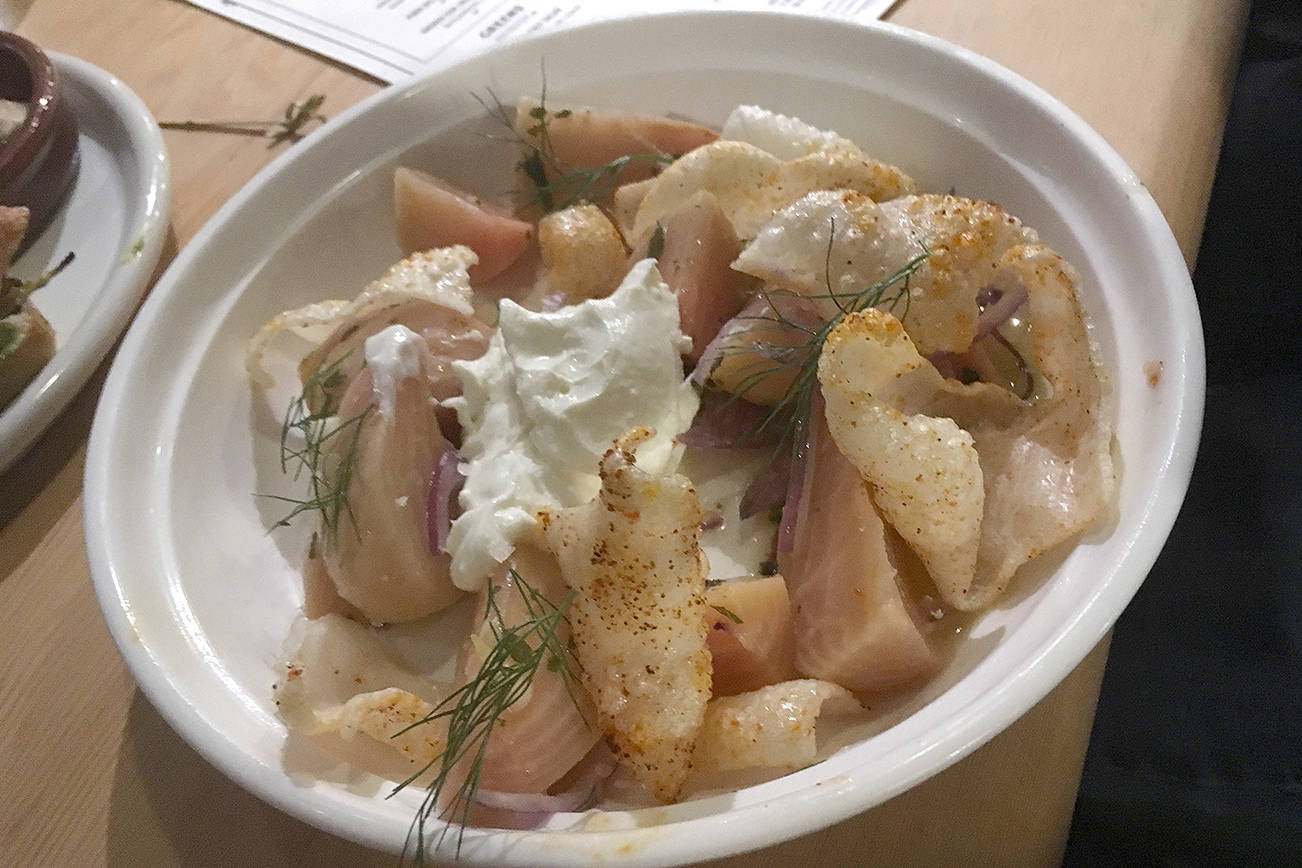The irony is not lost on me that Seattle Weekly recently covered the “holdouts” of South Lake Union: establishments like Re-bar and Glazer’s Camera that have yet to be bought up by developers in Amazonia—and that The Butcher’s Table on Westlake Avenue, kitty-corner from Whole Foods, is quite the opposite. In fact, the gargantuan space from Kurt Dammeier of the Sugar Mountain Group (Beecher’s, Bennett’s, Maximus/Minimus) testifies that SLU has officially become a “destination” with a capital D if ever there was one.
The 4,000-pound chandelier that resembles massive ice cubes dripping down the stairs of this two-story establishment signals entry into a rarefied atmosphere—where wood and steel and marble and leather all converge gracefully somehow, industrial chic and clubby classicism ensuring that both a CEO and a hipster coder (albeit a well-paid one) will feel at home. And while the bustling upstairs (which houses a butcher shop, deli, a raw bar, and a cocktail bar) allows you to indulge in the full dinner menu—or more humbly chow down on sandwiches—below is dinner-only. As you wind your way down to the subterranean space, your eyes need time to adjust to the ambient dark, where candles glow from a faux-fireplace and carefully placed ceiling lights give off just enough sparkle so that you can read your menu but barely make out the color of the black leather seats and the tufted couches raised dais-like in the corners. The large bar, semi-enclosed behind glass windows and concrete pillars, quietly radiates beyond.
This part of the restaurant, reservation-only, is a new kind of steakhouse, where their “Mishima Reserve” beef is the resulting hybrid of Japanese Black Wagyu bulls (bred for their extreme marbling) and American Black Angus cows, here served in cuts scaled by 4-, 5- and ultra- grades based on the Japanese rating system of marbling. (It’s worth noting, though, that the steaks here are not dry-aged, in case that’s something you look for at a high-end steakhouse.) Take your pick from Porterhouses and rib-eyes, as well as coulottes and flatirons. Or, if you’re new to Wagyu beef, it’s not a bad idea to opt for one of the steak tasting flights (a cringeworthy phrase, I know), which allow you to sample a 4-ounce portion of each grade ($70 for New York strip and $120 for cap of rib-eye). We went with the $70 option and had a good time comparing them. Ultimately I came away with more of an appreciation for the lesser grade (USDA prime), because, unlike the ultra—which is tender and buttery to the point of almost not even tasting like beef—it has that give, that bite-back, that I love about steak. It’s all really what you’re used to, I suppose, and I’m a rib-eye-on-sale-from-QFC kind of gal. In fact, the ultra is so marbleized that the chef recommends it served medium, as opposed to medium-rare. Otherwise it’d be tender to the point of becoming a kind of steak pudding.
Besides the steak, what’s also distinctive and quite simply spectacular here are the unconventional appetizers and sides. Double beef broth has the decadent flavor of a beef bourguignon, but in a strained amber liquid in which bob meaty chanterelles and morsels of shank, all ringing the centerpiece of a bone filled with creamy marrow to spread over buttery, toasted bread. Pieces of carrot and a smattering of parsley do a lovely job of subduing the lavishness. Likewise, a summer tomato salad is an utter delight, all sweet orange and yellow ripe halved baby tomatoes playing off the bright brine of Castelvetrano olives, a few stray pieces of little gem lettuce like tiny islands in a light coating of a tonnato sauce (made from seared ahi tuna), which lends it an air of a salade Niçoise while managing to be utterly original. Beef fat fries (perhaps more accurately described as oversized tater tots), a side dish, must be tried. Twice-fried, they settle into your mouth like creamy mashed potatoes, but doused in beef fat, rather than butter. Smoky grits, too, are a surprise of a side, corn-forward and sweet but roused with lightly charred chunks of zucchini and red bell pepper. We finished with a blackberry and peach crostata, a buttery, flaky package oozing with fruit.
Service was attentive and efficient, and though we had a waiter on his second night, any lapses in his knowledge were quickly cleared up by another waiter waiting in the wings. Waters were promptly refilled, tablecloths cleared of crumbs, and portions were happily divided in two for us to share. That fine line between care and hovering was respected. It felt like a special night out, but without bold face. It’s a steakhouse in theory, but manages to throw off much of the trademark stiltedness.
While it’s easy perhaps to fret over these shiny new pennies slowly infiltrating South Lake Union, there’s consolation in the fact that The Butcher’s Table has a welcoming, noisy atmosphere upstairs where you can eat sandwiches—and where seating of all kinds is abundant: a cozy sofa for two, a standard two-top, a spot at the bar, or a large table for a group of friends. And while the exclusive downstairs dining room is a place where serious cash is dropped, at least the food is thoughtful, original, and downright delicious. At the end of the night, It’s hard to hate on that.
food@seattleweekly.com









